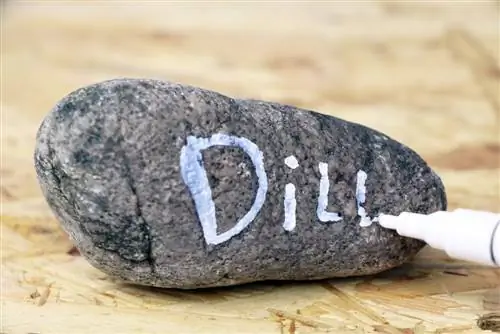- Author admin [email protected].
- Public 2023-12-17 03:39.
- Last modified 2025-01-24 12:45.
Inscribed stones are very popular. No wonder, because they can creatively replace place cards, be used in the garden or on the balcony to name plants, serve as a paperweight or individual decoration. Unfortunately, stones or slates that have already been described are comparatively expensive and can hardly be personalized. However, with our tips you can also do it on your own.
Sources
Stones can be found free of charge in nature and some people like to bring them with them from trips to the beach. However, not every stone is suitable for easy-to-read and durable labeling. Stones or slates with a very rough surface are much more difficult to write on and even if weatherproof pens are used, the paint or varnish will peel off. Stones that have already been polished are therefore better. For example, stones washed smooth by water.
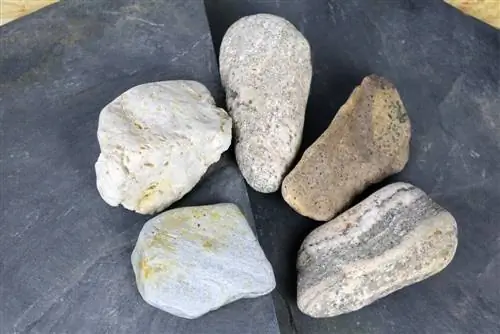
In addition to nature, there are also several other sources of suitable, polished stones. Below:
- Hardware store: Larger river pebbles, stone slabs, paving stones - the selection at the hardware store is large. The prices, however, are usually low. You can also easily purchase several stones with a similar shape, size and color.
- Roofer: Some roofers make slate panels as practice pieces. So it's worth asking.
- Steinmetz: Stones from a stonemason are more expensive, but also particularly elegant. Occasionally they also have decorative stone remnants left over, which they sell at a cheaper price.
- Craft supplies: Small decorative pebbles or glass “stones” can be found in well-stocked craft supplies. They are usually not very cheap, but are available in unusual colors.
- Decoration shops: The trade for decorative elements also occasionally offers stones and stone slabs.
- Aquarium and terrarium supplies: Unusual, noble types of stone are often used as decoration in aquariums and terrariums. It is therefore worth taking a look at various pet shops.
Stones, slate and more
In principle, any stone that has a surface that is as smooth as possible is suitable for labeling. But also:
- Clay and pottery shards with smooth edges
- Roof tiles
- washed glass
- petrified wood
Preparation
So that the inscription or pattern can be clearly seen later, the stones must be prepared accordingly. All you need to do is three steps.
- Soak the stones well and remove any remaining soil and dust using high water pressure or a brush.
- Rinse the stones until the water remains completely clear.
- Then pat dry well and let it dry for a few hours.
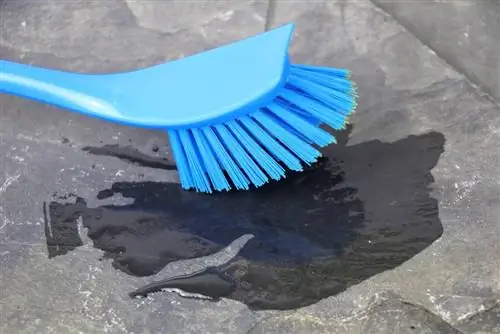
Cleaning and rinsing is important so that there is no dirt or dust on the surface. These could significantly shorten the durability of the labeling. Apart from this type of preparation, the stones or slate should already be written on or decorated with a pencil. In this way you can try out the desired font or pattern and adapt it optimally to the surface of the stone.
Labeling options
Waterproof labeling of stones is possible in two different ways. On the one hand, they can be decorated with suitable pens, paints or varnishes. On the other hand, engraving is also possible. The latter is a little more complex, but also more durable.
If you can't decide, you can also combine the two methods. For example, engrave the stone and color the engraving with pens or varnish, emphasize it or apply a decoration around the engraving.
Weatherproof pens and paints
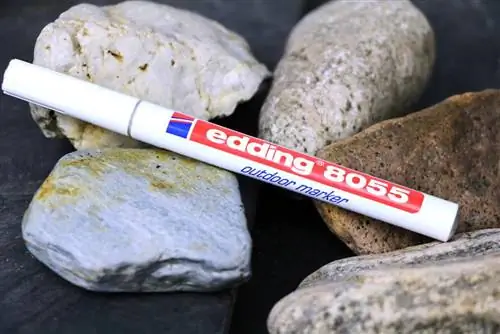
A very simple way to label stones is to write or draw with:
- weatherproof pins
- Colors for outdoor use
- Laquers
Suitable for this include:
- Edding pens for outdoor use
- Waterproof paints and varnishes
- Weatherproof pens, paints and varnishes
- Nail polish
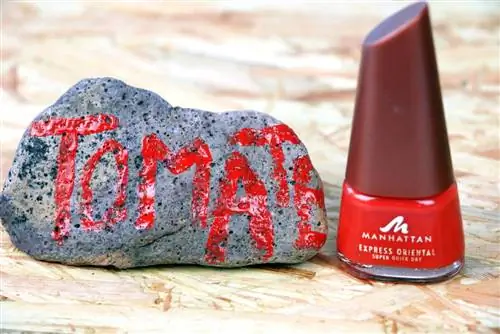
Since there are so many different ways to label slate and stone, creativity can run wild. Gold, silver, glitter, simple white or black and much more are available to choose from.
Engravings
Engraving stones sounds like a complicated and time-consuming task. In fact, all you need is a multi-tool - like a Dremel or a Proxxon - with appropriate drilling, grinding or engraving attachments.
When engraving, we recommend taking the following tips into account:
- Wear safety goggles and respiratory protection to protect eyes and respiratory tract from drilling dust
- Fix the stone with screw clamps or in a vice
- Wear work gloves
- work in an easy-to-clean area
- Use appropriate attachments to avoid damage and injury
Tip:
It makes sense to test and practice engraving beforehand on a practice piece made of the same material. This allows you to get a feel for the pressure with which you have to work and how the device and the stone or slate behave.
Sealing
No matter whether you choose to paint the stones or engrave them - so that the inscription remains attractive for a long time and is clearly visible, it should be sealed finally. This is particularly important if the labeled stones will be left outdoors all year round. Moisture, temperature fluctuations, sunlight but also insect droppings, moss and dirt can make both the color and the engraving illegible. On the one hand, sealing delays contamination. On the other hand, it becomes easier to clean the stones and slate if necessary.
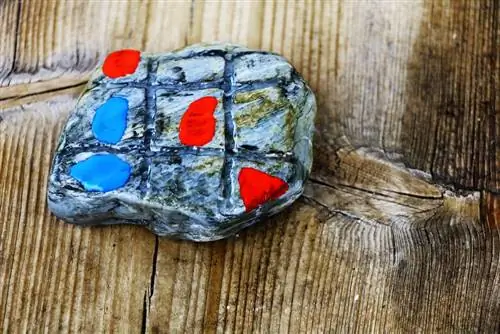
Before the sealant is applied, the stone should be clean, dust-free and dry. If it has been engraved, it should be rinsed and then dried well. For sealing, we recommend a transparent, weatherproof spray paint for outdoor use. In order to achieve consistent results, the following points must again be taken into account:
Order
It is advisable to use a protective base and spray the paint with even hand movements. Applying several coats can be useful.
Dry season
Since the stone can only be painted on one side at a time, it requires sufficient drying time after application. The duration depends on the respective paint and the temperature. Only when one side is completely dry should the next one be painted.
Cleanliness
The stones should be painted in a clean, dry and dust-free environment. This reduces the risk of contaminants sticking to the drying paint - such as dust, lint, leaves or other dirt - and the result is more even.
Tip:
Applying several coats of varnish is not absolutely necessary if the inscribed stones are used indoors or rarely come into contact with moisture and dirt.

